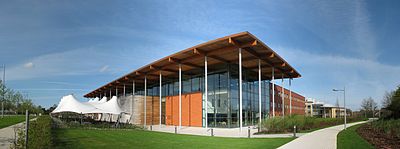- University of Cambridge Computer Laboratory
-
 The Computer Laboratory has been housed in the William Gates Building in West Cambridge since August 2001.
The Computer Laboratory has been housed in the William Gates Building in West Cambridge since August 2001.
The Computer Laboratory is the computer science department of the University of Cambridge. As of 2007, it employs 35 academic staff, 25 support staff, 35 affiliated research staff, and about 155 research students. The current head of department is Professor Andy Hopper.
The Computer Laboratory built and operated the world’s first practical stored program computer (EDSAC, 1949) and offered the world’s first taught course in computer science in 1953. It currently offers a 3-year undergraduate course and a 1-year masters course (with an optional natural language processing theme). Recent research has focused on virtualization, security, usability, formal verification, formal semantics of programming languages, computer architecture, natural language processing, wireless networking, biometric identification, routing, positioning systems and has achieved the top ratings in recent UK Research Assessment Exercise evaluations. A new research focus is sustainability (“Computing for the future of the planet”). Members of the Computer Laboratory have been involved in the creation of many successful UK IT companies such as Acorn, ARM, nCipher and XenSource.
Contents
History
It was founded as the Mathematical Laboratory under the leadership of John Lennard-Jones on 14 May 1937, though it did not get properly established until after World War II. Upon its foundation, it was intended to provide a computing service for general use, and to be a centre for the development of computational techniques in the University. The Cambridge Diploma in Computer Science was the world’s first taught course in computing, starting in 1953.
In October 1946, work began under Maurice Wilkes on EDSAC (Electronic Delay Storage Automatic Calculator), which subsequently became the world’s first fully operational and practical stored program computer when it ran its first program on 6 May 1949. It inspired the world’s first business computer, LEO. It was replaced by EDSAC 2, the first microcoded and bitsliced computer, in 1958.
In 1961, David F. Hartley developed Autocode, one of the first high-level programming languages, for EDSAC 2. Also in that year, proposals for Titan, based on the Ferranti Atlas machine, were developed. Titan became fully operational in 1964 and EDSAC 2 was retired the following year. In 1967, a full (‘24/7’) multi-user time-shared service for up to 64 users was inaugurated on Titan.
In 1970, the Mathematical Laboratory was renamed the Computer Laboratory, with separate departments for Teaching and Research and the Computing Service, providing computing services to the university and its colleges. The two did not fully separate until 2001, when the Computer Laboratory moved out to the new William Gates building in West Cambridge, off Madingley Road, leaving behind an independent Computing Service.
In 2002, the Computer Laboratory launched the Cambridge Computer Lab Ring, a graduate society named after the Cambridge Ring network.
Staff
See also: Category:Members of the University of Cambridge Computer Laboratory- Selected current staff members
- Ross Anderson
- Jon Crowcroft
- Mike Gordon
- Andy Hopper
- Markus Kuhn
- Lawrence Paulson
- Martin Richards
- Peter Robinson
- Former staff include
Heads of the Computer Laboratory
- 1949 Maurice Wilkes
- 1980 Roger Needham
- 1996 Robin Milner
- 1999 Ian Leslie
- 2004 Andy Hopper
Landmark projects and results
- EDSAC – world’s first practical stored program electronic computer (1949–1958)
- Subroutine (1951)
- OXO – world’s first video game (1952)
- EDSAC 2 (1958–1965)
- Autocode – one of the first high-level programming languages (1961)
- Titan – early multi-user time-share computer (1964–1973)
- Phoenix – IBM 370 with locally developed OS and hardware extensions (1973–1995)
- TRIPOS operating system – became later the basis for AmigaDOS
- BCPL programming language – ancestor of C
- CAP computer – hardware support for capability-based security
- Cambridge Ring – an early local area network
- Cambridge Distributed Computing System
- Trojan Room coffee pot – the world’s first webcam (1993)
- Iris recognition – biometric identification with vanishingly small false-accept rate
- Nemesis – real-time microkernel OS
- Active Bat – ultrasonic indoor positioning system
- Xen – virtual machine monitor (2003–present)
External links
- University of Cambridge Computer Laboratory
- University of Cambridge Computing Service
- A brief informal history of the Computer Laboratory
- Location of the Computer Laboratory
- Cambridge Computer Lab Ring
Coordinates: 52°12′39″N 0°05′31″E / 52.210925°N 0.092022°E
Categories:- University of Cambridge Computer Laboratory
- 1937 establishments in England
- Departments of the University of Cambridge
- University and college laboratories in the United Kingdom
- Computer science departments in the United Kingdom
Wikimedia Foundation. 2010.
